Organizational Communication and Processes
VerifiedAdded on 2020/02/24
|11
|3729
|51
AI Summary
This assignment delves into the crucial role of organizational communication. Students are tasked with examining various approaches and processes within organizational communication, analyzing their impact on workplace dynamics and overall organizational success. The assignment encourages critical evaluation of theories and models while highlighting best practices for effective communication in diverse organizational settings.
Contribute Materials
Your contribution can guide someone’s learning journey. Share your
documents today.
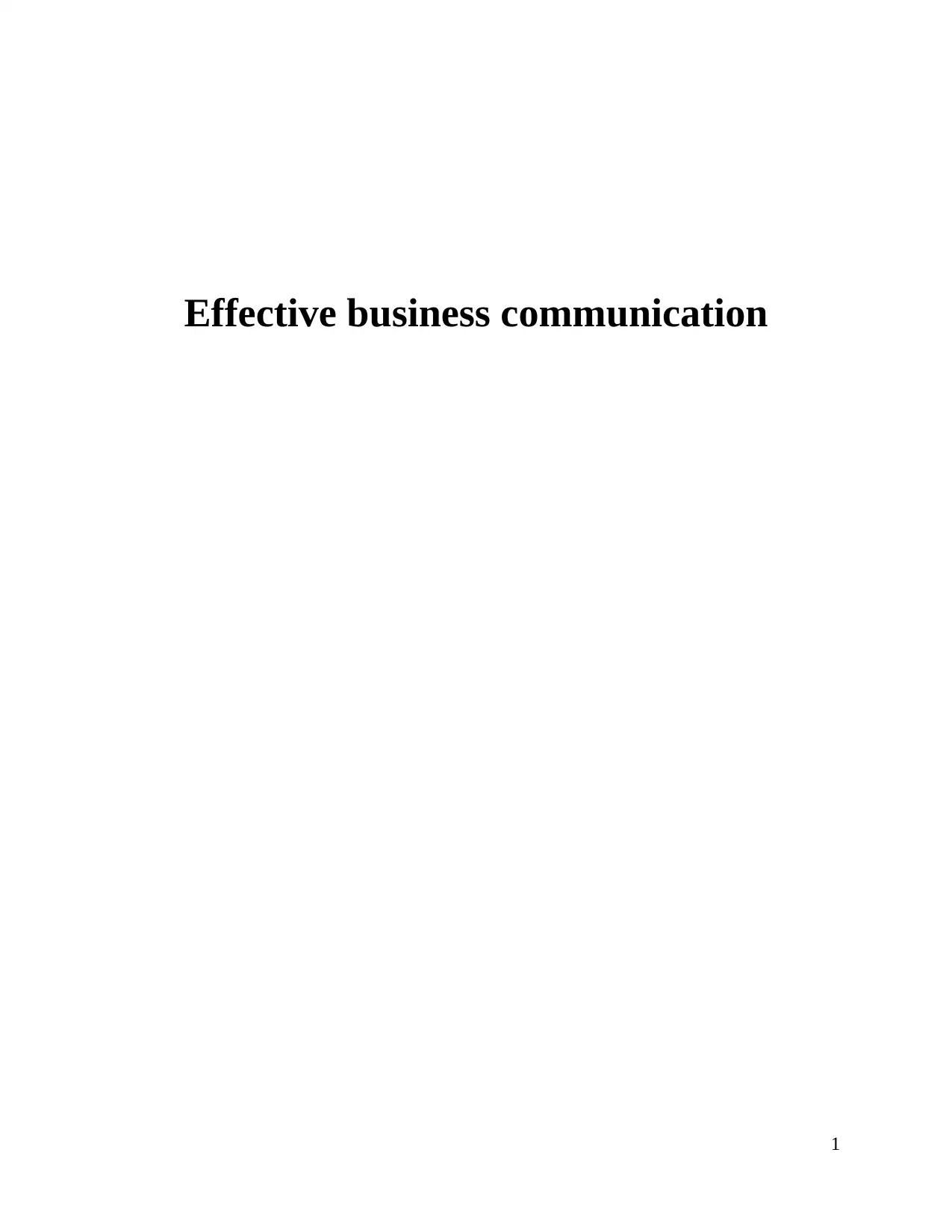
Effective business communication
1
1
Secure Best Marks with AI Grader
Need help grading? Try our AI Grader for instant feedback on your assignments.
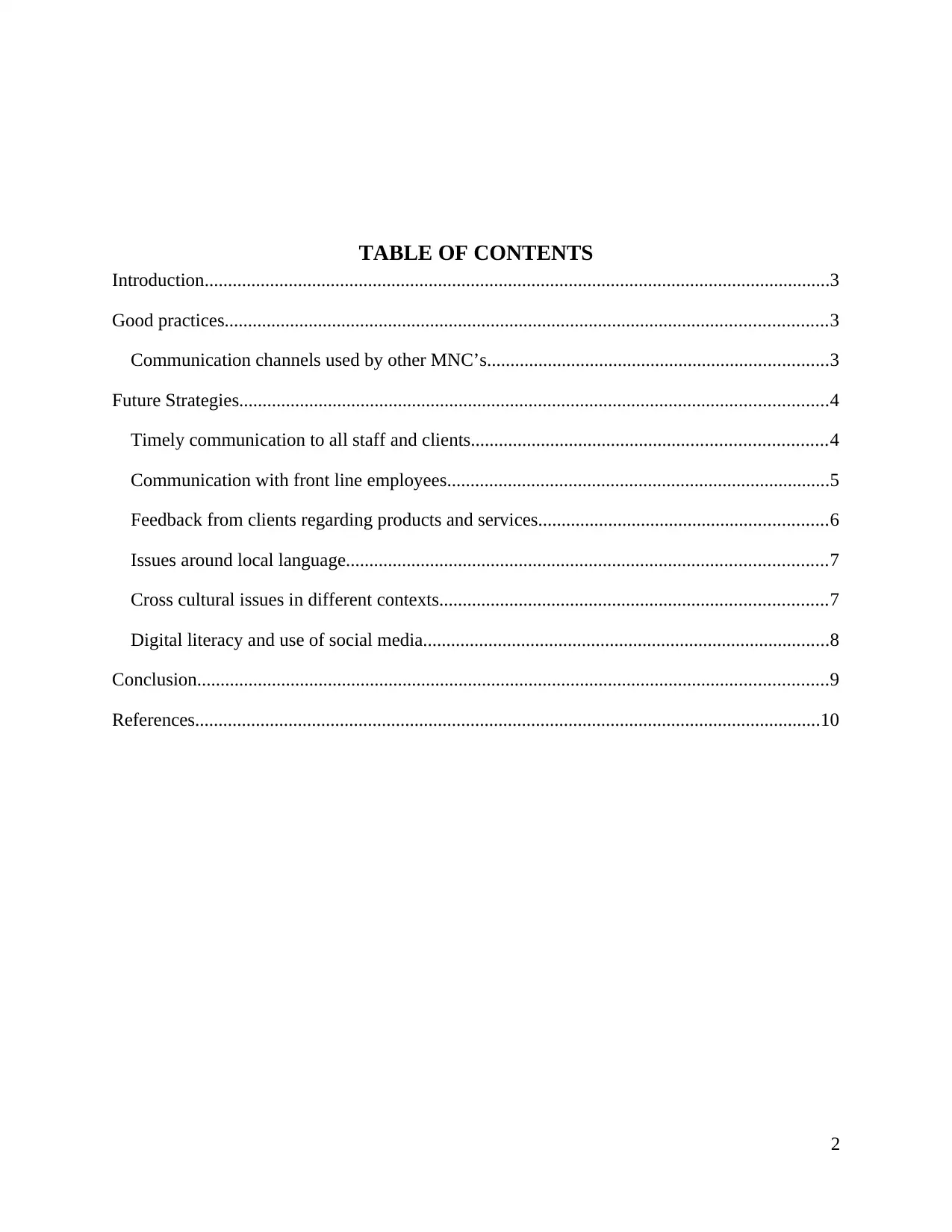
TABLE OF CONTENTS
Introduction......................................................................................................................................3
Good practices.................................................................................................................................3
Communication channels used by other MNC’s.........................................................................3
Future Strategies..............................................................................................................................4
Timely communication to all staff and clients............................................................................4
Communication with front line employees..................................................................................5
Feedback from clients regarding products and services..............................................................6
Issues around local language.......................................................................................................7
Cross cultural issues in different contexts...................................................................................7
Digital literacy and use of social media.......................................................................................8
Conclusion.......................................................................................................................................9
References......................................................................................................................................10
2
Introduction......................................................................................................................................3
Good practices.................................................................................................................................3
Communication channels used by other MNC’s.........................................................................3
Future Strategies..............................................................................................................................4
Timely communication to all staff and clients............................................................................4
Communication with front line employees..................................................................................5
Feedback from clients regarding products and services..............................................................6
Issues around local language.......................................................................................................7
Cross cultural issues in different contexts...................................................................................7
Digital literacy and use of social media.......................................................................................8
Conclusion.......................................................................................................................................9
References......................................................................................................................................10
2
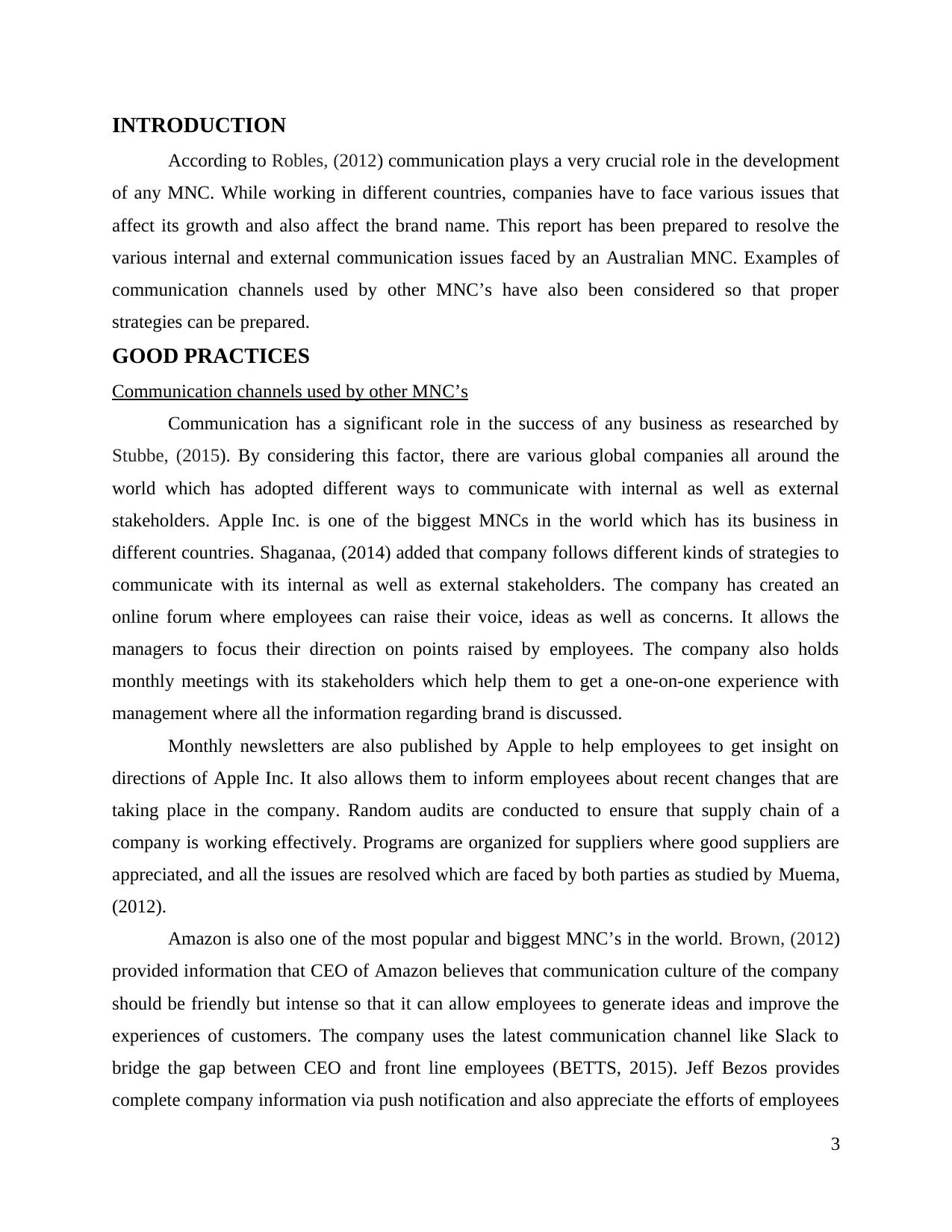
INTRODUCTION
According to Robles, (2012) communication plays a very crucial role in the development
of any MNC. While working in different countries, companies have to face various issues that
affect its growth and also affect the brand name. This report has been prepared to resolve the
various internal and external communication issues faced by an Australian MNC. Examples of
communication channels used by other MNC’s have also been considered so that proper
strategies can be prepared.
GOOD PRACTICES
Communication channels used by other MNC’s
Communication has a significant role in the success of any business as researched by
Stubbe, (2015). By considering this factor, there are various global companies all around the
world which has adopted different ways to communicate with internal as well as external
stakeholders. Apple Inc. is one of the biggest MNCs in the world which has its business in
different countries. Shaganaa, (2014) added that company follows different kinds of strategies to
communicate with its internal as well as external stakeholders. The company has created an
online forum where employees can raise their voice, ideas as well as concerns. It allows the
managers to focus their direction on points raised by employees. The company also holds
monthly meetings with its stakeholders which help them to get a one-on-one experience with
management where all the information regarding brand is discussed.
Monthly newsletters are also published by Apple to help employees to get insight on
directions of Apple Inc. It also allows them to inform employees about recent changes that are
taking place in the company. Random audits are conducted to ensure that supply chain of a
company is working effectively. Programs are organized for suppliers where good suppliers are
appreciated, and all the issues are resolved which are faced by both parties as studied by Muema,
(2012).
Amazon is also one of the most popular and biggest MNC’s in the world. Brown, (2012)
provided information that CEO of Amazon believes that communication culture of the company
should be friendly but intense so that it can allow employees to generate ideas and improve the
experiences of customers. The company uses the latest communication channel like Slack to
bridge the gap between CEO and front line employees (BETTS, 2015). Jeff Bezos provides
complete company information via push notification and also appreciate the efforts of employees
3
According to Robles, (2012) communication plays a very crucial role in the development
of any MNC. While working in different countries, companies have to face various issues that
affect its growth and also affect the brand name. This report has been prepared to resolve the
various internal and external communication issues faced by an Australian MNC. Examples of
communication channels used by other MNC’s have also been considered so that proper
strategies can be prepared.
GOOD PRACTICES
Communication channels used by other MNC’s
Communication has a significant role in the success of any business as researched by
Stubbe, (2015). By considering this factor, there are various global companies all around the
world which has adopted different ways to communicate with internal as well as external
stakeholders. Apple Inc. is one of the biggest MNCs in the world which has its business in
different countries. Shaganaa, (2014) added that company follows different kinds of strategies to
communicate with its internal as well as external stakeholders. The company has created an
online forum where employees can raise their voice, ideas as well as concerns. It allows the
managers to focus their direction on points raised by employees. The company also holds
monthly meetings with its stakeholders which help them to get a one-on-one experience with
management where all the information regarding brand is discussed.
Monthly newsletters are also published by Apple to help employees to get insight on
directions of Apple Inc. It also allows them to inform employees about recent changes that are
taking place in the company. Random audits are conducted to ensure that supply chain of a
company is working effectively. Programs are organized for suppliers where good suppliers are
appreciated, and all the issues are resolved which are faced by both parties as studied by Muema,
(2012).
Amazon is also one of the most popular and biggest MNC’s in the world. Brown, (2012)
provided information that CEO of Amazon believes that communication culture of the company
should be friendly but intense so that it can allow employees to generate ideas and improve the
experiences of customers. The company uses the latest communication channel like Slack to
bridge the gap between CEO and front line employees (BETTS, 2015). Jeff Bezos provides
complete company information via push notification and also appreciate the efforts of employees
3
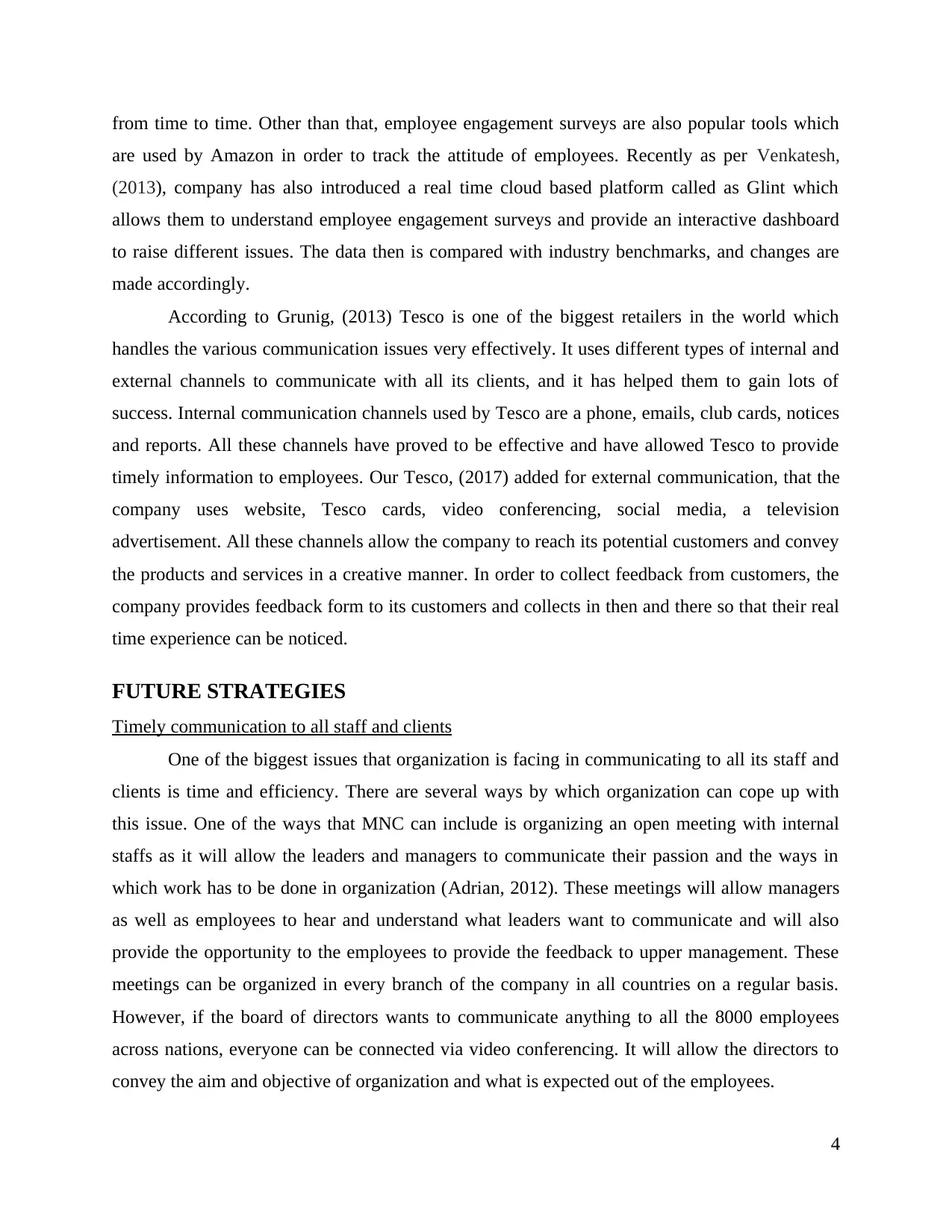
from time to time. Other than that, employee engagement surveys are also popular tools which
are used by Amazon in order to track the attitude of employees. Recently as per Venkatesh,
(2013), company has also introduced a real time cloud based platform called as Glint which
allows them to understand employee engagement surveys and provide an interactive dashboard
to raise different issues. The data then is compared with industry benchmarks, and changes are
made accordingly.
According to Grunig, (2013) Tesco is one of the biggest retailers in the world which
handles the various communication issues very effectively. It uses different types of internal and
external channels to communicate with all its clients, and it has helped them to gain lots of
success. Internal communication channels used by Tesco are a phone, emails, club cards, notices
and reports. All these channels have proved to be effective and have allowed Tesco to provide
timely information to employees. Our Tesco, (2017) added for external communication, that the
company uses website, Tesco cards, video conferencing, social media, a television
advertisement. All these channels allow the company to reach its potential customers and convey
the products and services in a creative manner. In order to collect feedback from customers, the
company provides feedback form to its customers and collects in then and there so that their real
time experience can be noticed.
FUTURE STRATEGIES
Timely communication to all staff and clients
One of the biggest issues that organization is facing in communicating to all its staff and
clients is time and efficiency. There are several ways by which organization can cope up with
this issue. One of the ways that MNC can include is organizing an open meeting with internal
staffs as it will allow the leaders and managers to communicate their passion and the ways in
which work has to be done in organization (Adrian, 2012). These meetings will allow managers
as well as employees to hear and understand what leaders want to communicate and will also
provide the opportunity to the employees to provide the feedback to upper management. These
meetings can be organized in every branch of the company in all countries on a regular basis.
However, if the board of directors wants to communicate anything to all the 8000 employees
across nations, everyone can be connected via video conferencing. It will allow the directors to
convey the aim and objective of organization and what is expected out of the employees.
4
are used by Amazon in order to track the attitude of employees. Recently as per Venkatesh,
(2013), company has also introduced a real time cloud based platform called as Glint which
allows them to understand employee engagement surveys and provide an interactive dashboard
to raise different issues. The data then is compared with industry benchmarks, and changes are
made accordingly.
According to Grunig, (2013) Tesco is one of the biggest retailers in the world which
handles the various communication issues very effectively. It uses different types of internal and
external channels to communicate with all its clients, and it has helped them to gain lots of
success. Internal communication channels used by Tesco are a phone, emails, club cards, notices
and reports. All these channels have proved to be effective and have allowed Tesco to provide
timely information to employees. Our Tesco, (2017) added for external communication, that the
company uses website, Tesco cards, video conferencing, social media, a television
advertisement. All these channels allow the company to reach its potential customers and convey
the products and services in a creative manner. In order to collect feedback from customers, the
company provides feedback form to its customers and collects in then and there so that their real
time experience can be noticed.
FUTURE STRATEGIES
Timely communication to all staff and clients
One of the biggest issues that organization is facing in communicating to all its staff and
clients is time and efficiency. There are several ways by which organization can cope up with
this issue. One of the ways that MNC can include is organizing an open meeting with internal
staffs as it will allow the leaders and managers to communicate their passion and the ways in
which work has to be done in organization (Adrian, 2012). These meetings will allow managers
as well as employees to hear and understand what leaders want to communicate and will also
provide the opportunity to the employees to provide the feedback to upper management. These
meetings can be organized in every branch of the company in all countries on a regular basis.
However, if the board of directors wants to communicate anything to all the 8000 employees
across nations, everyone can be connected via video conferencing. It will allow the directors to
convey the aim and objective of organization and what is expected out of the employees.
4
Secure Best Marks with AI Grader
Need help grading? Try our AI Grader for instant feedback on your assignments.
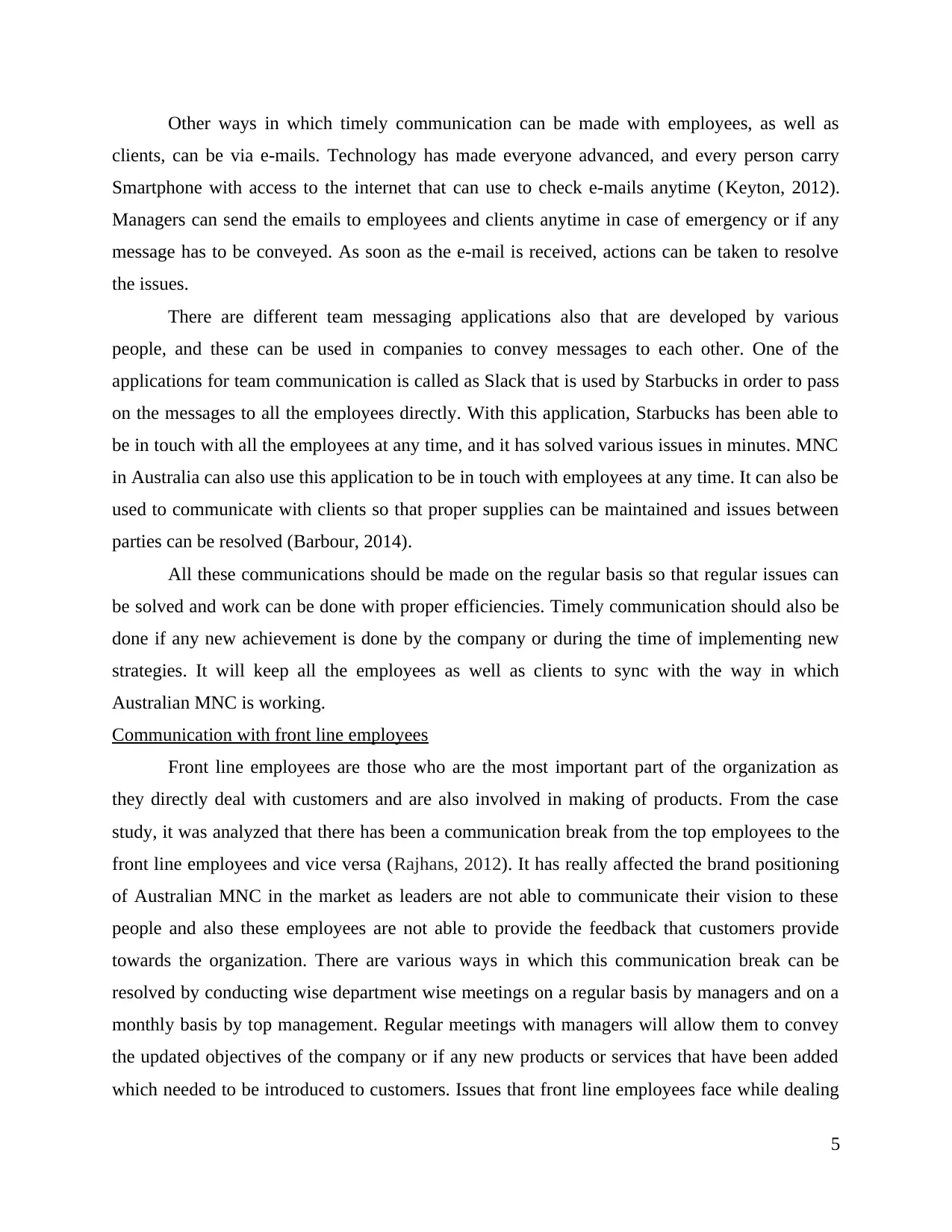
Other ways in which timely communication can be made with employees, as well as
clients, can be via e-mails. Technology has made everyone advanced, and every person carry
Smartphone with access to the internet that can use to check e-mails anytime (Keyton, 2012).
Managers can send the emails to employees and clients anytime in case of emergency or if any
message has to be conveyed. As soon as the e-mail is received, actions can be taken to resolve
the issues.
There are different team messaging applications also that are developed by various
people, and these can be used in companies to convey messages to each other. One of the
applications for team communication is called as Slack that is used by Starbucks in order to pass
on the messages to all the employees directly. With this application, Starbucks has been able to
be in touch with all the employees at any time, and it has solved various issues in minutes. MNC
in Australia can also use this application to be in touch with employees at any time. It can also be
used to communicate with clients so that proper supplies can be maintained and issues between
parties can be resolved (Barbour, 2014).
All these communications should be made on the regular basis so that regular issues can
be solved and work can be done with proper efficiencies. Timely communication should also be
done if any new achievement is done by the company or during the time of implementing new
strategies. It will keep all the employees as well as clients to sync with the way in which
Australian MNC is working.
Communication with front line employees
Front line employees are those who are the most important part of the organization as
they directly deal with customers and are also involved in making of products. From the case
study, it was analyzed that there has been a communication break from the top employees to the
front line employees and vice versa (Rajhans, 2012). It has really affected the brand positioning
of Australian MNC in the market as leaders are not able to communicate their vision to these
people and also these employees are not able to provide the feedback that customers provide
towards the organization. There are various ways in which this communication break can be
resolved by conducting wise department wise meetings on a regular basis by managers and on a
monthly basis by top management. Regular meetings with managers will allow them to convey
the updated objectives of the company or if any new products or services that have been added
which needed to be introduced to customers. Issues that front line employees face while dealing
5
clients, can be via e-mails. Technology has made everyone advanced, and every person carry
Smartphone with access to the internet that can use to check e-mails anytime (Keyton, 2012).
Managers can send the emails to employees and clients anytime in case of emergency or if any
message has to be conveyed. As soon as the e-mail is received, actions can be taken to resolve
the issues.
There are different team messaging applications also that are developed by various
people, and these can be used in companies to convey messages to each other. One of the
applications for team communication is called as Slack that is used by Starbucks in order to pass
on the messages to all the employees directly. With this application, Starbucks has been able to
be in touch with all the employees at any time, and it has solved various issues in minutes. MNC
in Australia can also use this application to be in touch with employees at any time. It can also be
used to communicate with clients so that proper supplies can be maintained and issues between
parties can be resolved (Barbour, 2014).
All these communications should be made on the regular basis so that regular issues can
be solved and work can be done with proper efficiencies. Timely communication should also be
done if any new achievement is done by the company or during the time of implementing new
strategies. It will keep all the employees as well as clients to sync with the way in which
Australian MNC is working.
Communication with front line employees
Front line employees are those who are the most important part of the organization as
they directly deal with customers and are also involved in making of products. From the case
study, it was analyzed that there has been a communication break from the top employees to the
front line employees and vice versa (Rajhans, 2012). It has really affected the brand positioning
of Australian MNC in the market as leaders are not able to communicate their vision to these
people and also these employees are not able to provide the feedback that customers provide
towards the organization. There are various ways in which this communication break can be
resolved by conducting wise department wise meetings on a regular basis by managers and on a
monthly basis by top management. Regular meetings with managers will allow them to convey
the updated objectives of the company or if any new products or services that have been added
which needed to be introduced to customers. Issues that front line employees face while dealing
5
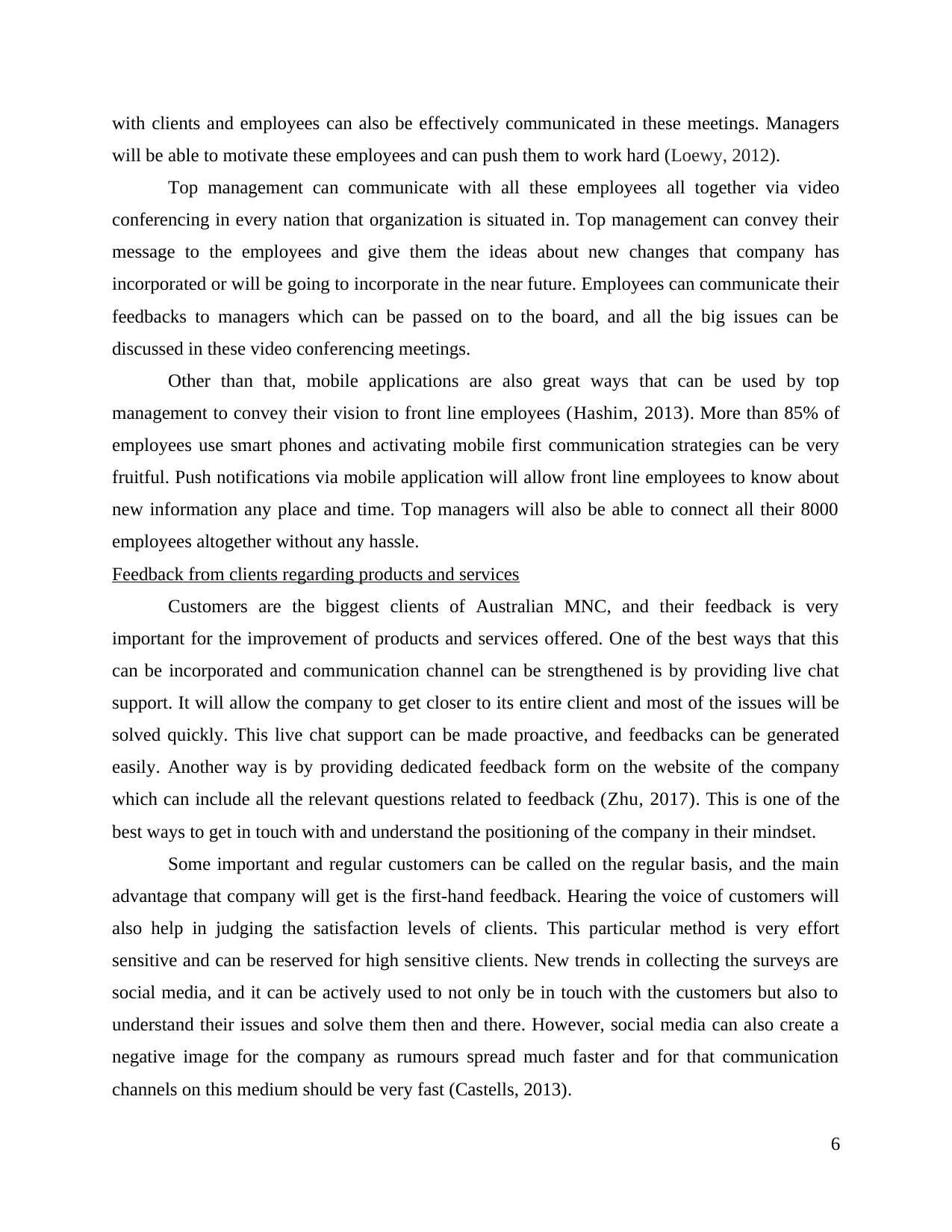
with clients and employees can also be effectively communicated in these meetings. Managers
will be able to motivate these employees and can push them to work hard (Loewy, 2012).
Top management can communicate with all these employees all together via video
conferencing in every nation that organization is situated in. Top management can convey their
message to the employees and give them the ideas about new changes that company has
incorporated or will be going to incorporate in the near future. Employees can communicate their
feedbacks to managers which can be passed on to the board, and all the big issues can be
discussed in these video conferencing meetings.
Other than that, mobile applications are also great ways that can be used by top
management to convey their vision to front line employees (Hashim, 2013). More than 85% of
employees use smart phones and activating mobile first communication strategies can be very
fruitful. Push notifications via mobile application will allow front line employees to know about
new information any place and time. Top managers will also be able to connect all their 8000
employees altogether without any hassle.
Feedback from clients regarding products and services
Customers are the biggest clients of Australian MNC, and their feedback is very
important for the improvement of products and services offered. One of the best ways that this
can be incorporated and communication channel can be strengthened is by providing live chat
support. It will allow the company to get closer to its entire client and most of the issues will be
solved quickly. This live chat support can be made proactive, and feedbacks can be generated
easily. Another way is by providing dedicated feedback form on the website of the company
which can include all the relevant questions related to feedback (Zhu, 2017). This is one of the
best ways to get in touch with and understand the positioning of the company in their mindset.
Some important and regular customers can be called on the regular basis, and the main
advantage that company will get is the first-hand feedback. Hearing the voice of customers will
also help in judging the satisfaction levels of clients. This particular method is very effort
sensitive and can be reserved for high sensitive clients. New trends in collecting the surveys are
social media, and it can be actively used to not only be in touch with the customers but also to
understand their issues and solve them then and there. However, social media can also create a
negative image for the company as rumours spread much faster and for that communication
channels on this medium should be very fast (Castells, 2013).
6
will be able to motivate these employees and can push them to work hard (Loewy, 2012).
Top management can communicate with all these employees all together via video
conferencing in every nation that organization is situated in. Top management can convey their
message to the employees and give them the ideas about new changes that company has
incorporated or will be going to incorporate in the near future. Employees can communicate their
feedbacks to managers which can be passed on to the board, and all the big issues can be
discussed in these video conferencing meetings.
Other than that, mobile applications are also great ways that can be used by top
management to convey their vision to front line employees (Hashim, 2013). More than 85% of
employees use smart phones and activating mobile first communication strategies can be very
fruitful. Push notifications via mobile application will allow front line employees to know about
new information any place and time. Top managers will also be able to connect all their 8000
employees altogether without any hassle.
Feedback from clients regarding products and services
Customers are the biggest clients of Australian MNC, and their feedback is very
important for the improvement of products and services offered. One of the best ways that this
can be incorporated and communication channel can be strengthened is by providing live chat
support. It will allow the company to get closer to its entire client and most of the issues will be
solved quickly. This live chat support can be made proactive, and feedbacks can be generated
easily. Another way is by providing dedicated feedback form on the website of the company
which can include all the relevant questions related to feedback (Zhu, 2017). This is one of the
best ways to get in touch with and understand the positioning of the company in their mindset.
Some important and regular customers can be called on the regular basis, and the main
advantage that company will get is the first-hand feedback. Hearing the voice of customers will
also help in judging the satisfaction levels of clients. This particular method is very effort
sensitive and can be reserved for high sensitive clients. New trends in collecting the surveys are
social media, and it can be actively used to not only be in touch with the customers but also to
understand their issues and solve them then and there. However, social media can also create a
negative image for the company as rumours spread much faster and for that communication
channels on this medium should be very fast (Castells, 2013).
6
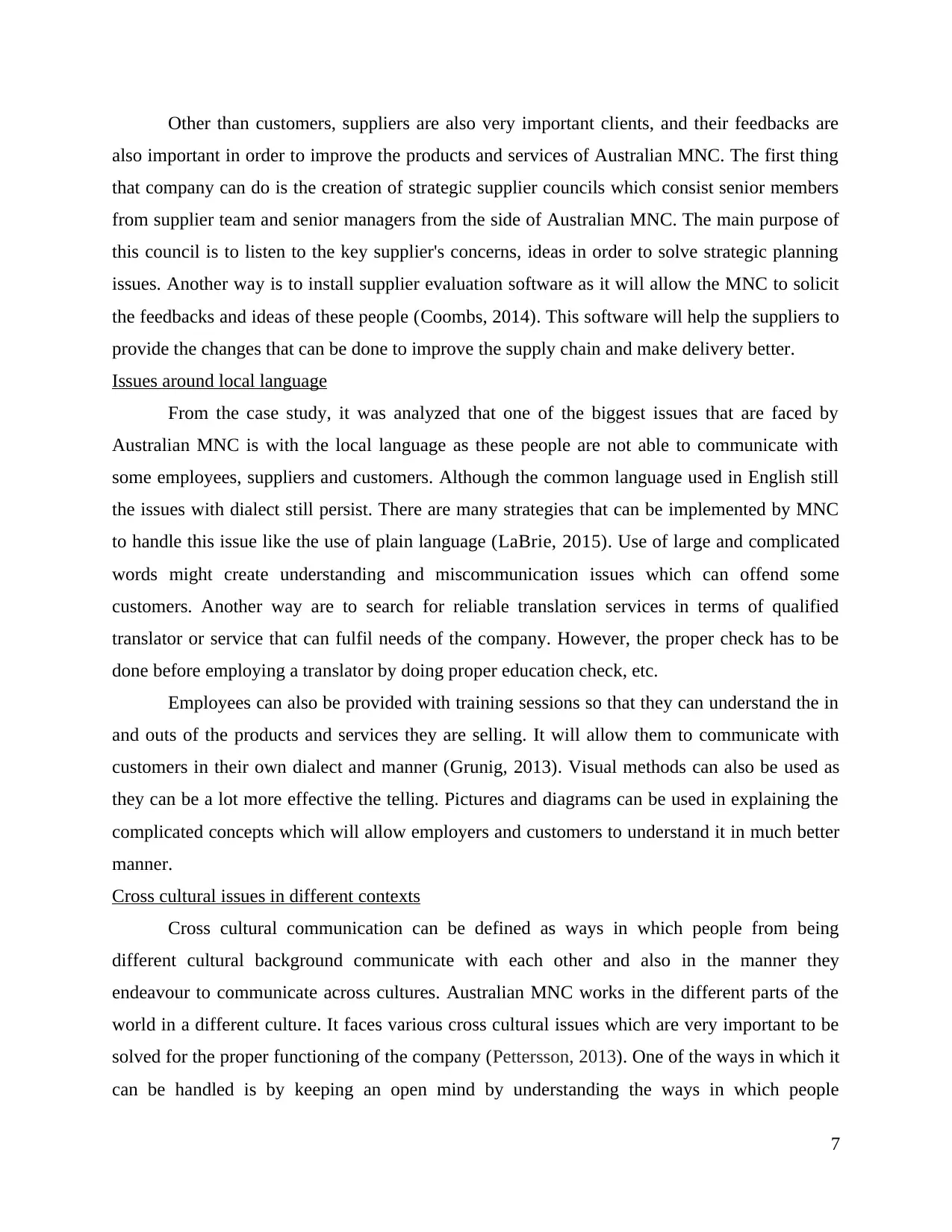
Other than customers, suppliers are also very important clients, and their feedbacks are
also important in order to improve the products and services of Australian MNC. The first thing
that company can do is the creation of strategic supplier councils which consist senior members
from supplier team and senior managers from the side of Australian MNC. The main purpose of
this council is to listen to the key supplier's concerns, ideas in order to solve strategic planning
issues. Another way is to install supplier evaluation software as it will allow the MNC to solicit
the feedbacks and ideas of these people (Coombs, 2014). This software will help the suppliers to
provide the changes that can be done to improve the supply chain and make delivery better.
Issues around local language
From the case study, it was analyzed that one of the biggest issues that are faced by
Australian MNC is with the local language as these people are not able to communicate with
some employees, suppliers and customers. Although the common language used in English still
the issues with dialect still persist. There are many strategies that can be implemented by MNC
to handle this issue like the use of plain language (LaBrie, 2015). Use of large and complicated
words might create understanding and miscommunication issues which can offend some
customers. Another way are to search for reliable translation services in terms of qualified
translator or service that can fulfil needs of the company. However, the proper check has to be
done before employing a translator by doing proper education check, etc.
Employees can also be provided with training sessions so that they can understand the in
and outs of the products and services they are selling. It will allow them to communicate with
customers in their own dialect and manner (Grunig, 2013). Visual methods can also be used as
they can be a lot more effective the telling. Pictures and diagrams can be used in explaining the
complicated concepts which will allow employers and customers to understand it in much better
manner.
Cross cultural issues in different contexts
Cross cultural communication can be defined as ways in which people from being
different cultural background communicate with each other and also in the manner they
endeavour to communicate across cultures. Australian MNC works in the different parts of the
world in a different culture. It faces various cross cultural issues which are very important to be
solved for the proper functioning of the company (Pettersson, 2013). One of the ways in which it
can be handled is by keeping an open mind by understanding the ways in which people
7
also important in order to improve the products and services of Australian MNC. The first thing
that company can do is the creation of strategic supplier councils which consist senior members
from supplier team and senior managers from the side of Australian MNC. The main purpose of
this council is to listen to the key supplier's concerns, ideas in order to solve strategic planning
issues. Another way is to install supplier evaluation software as it will allow the MNC to solicit
the feedbacks and ideas of these people (Coombs, 2014). This software will help the suppliers to
provide the changes that can be done to improve the supply chain and make delivery better.
Issues around local language
From the case study, it was analyzed that one of the biggest issues that are faced by
Australian MNC is with the local language as these people are not able to communicate with
some employees, suppliers and customers. Although the common language used in English still
the issues with dialect still persist. There are many strategies that can be implemented by MNC
to handle this issue like the use of plain language (LaBrie, 2015). Use of large and complicated
words might create understanding and miscommunication issues which can offend some
customers. Another way are to search for reliable translation services in terms of qualified
translator or service that can fulfil needs of the company. However, the proper check has to be
done before employing a translator by doing proper education check, etc.
Employees can also be provided with training sessions so that they can understand the in
and outs of the products and services they are selling. It will allow them to communicate with
customers in their own dialect and manner (Grunig, 2013). Visual methods can also be used as
they can be a lot more effective the telling. Pictures and diagrams can be used in explaining the
complicated concepts which will allow employers and customers to understand it in much better
manner.
Cross cultural issues in different contexts
Cross cultural communication can be defined as ways in which people from being
different cultural background communicate with each other and also in the manner they
endeavour to communicate across cultures. Australian MNC works in the different parts of the
world in a different culture. It faces various cross cultural issues which are very important to be
solved for the proper functioning of the company (Pettersson, 2013). One of the ways in which it
can be handled is by keeping an open mind by understanding the ways in which people
7
Paraphrase This Document
Need a fresh take? Get an instant paraphrase of this document with our AI Paraphraser
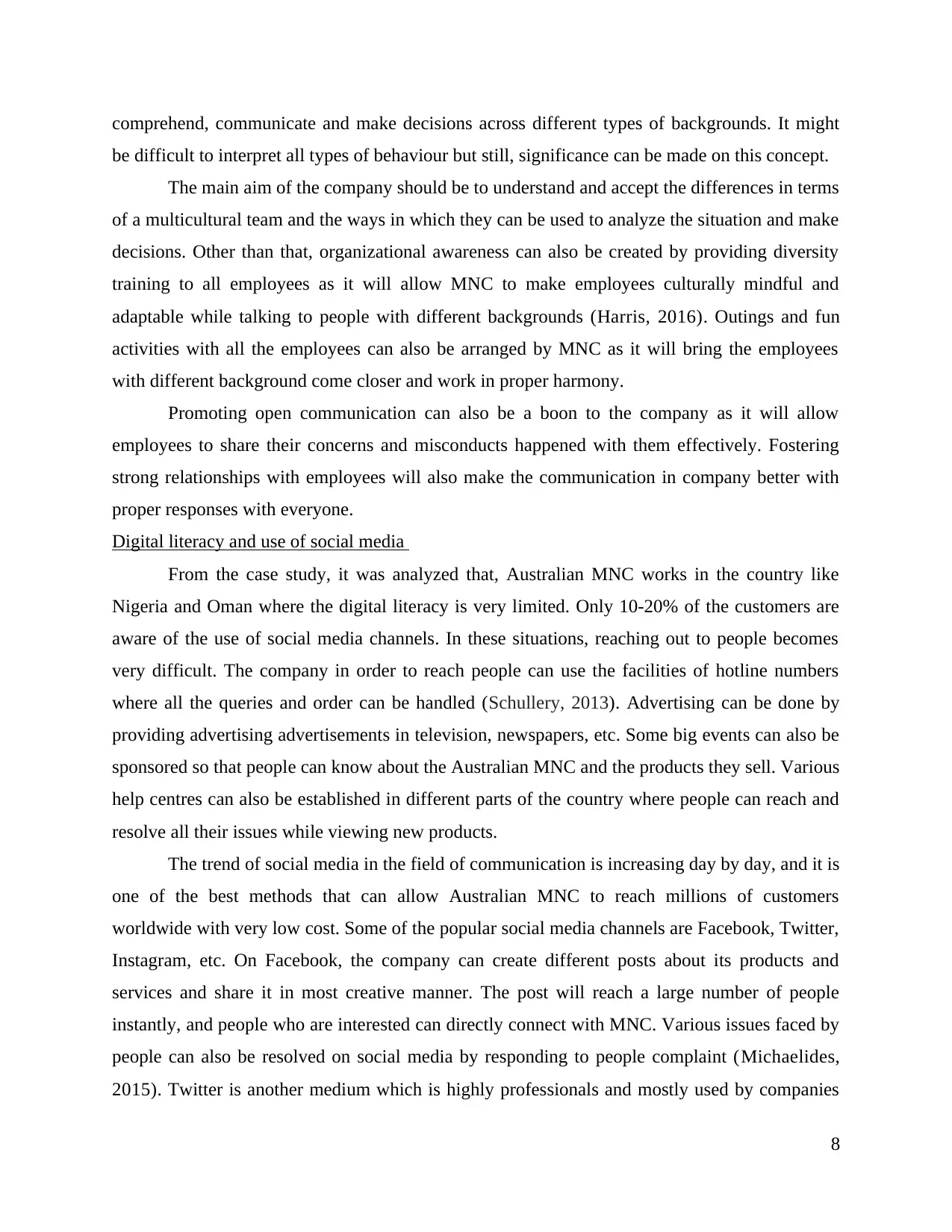
comprehend, communicate and make decisions across different types of backgrounds. It might
be difficult to interpret all types of behaviour but still, significance can be made on this concept.
The main aim of the company should be to understand and accept the differences in terms
of a multicultural team and the ways in which they can be used to analyze the situation and make
decisions. Other than that, organizational awareness can also be created by providing diversity
training to all employees as it will allow MNC to make employees culturally mindful and
adaptable while talking to people with different backgrounds (Harris, 2016). Outings and fun
activities with all the employees can also be arranged by MNC as it will bring the employees
with different background come closer and work in proper harmony.
Promoting open communication can also be a boon to the company as it will allow
employees to share their concerns and misconducts happened with them effectively. Fostering
strong relationships with employees will also make the communication in company better with
proper responses with everyone.
Digital literacy and use of social media
From the case study, it was analyzed that, Australian MNC works in the country like
Nigeria and Oman where the digital literacy is very limited. Only 10-20% of the customers are
aware of the use of social media channels. In these situations, reaching out to people becomes
very difficult. The company in order to reach people can use the facilities of hotline numbers
where all the queries and order can be handled (Schullery, 2013). Advertising can be done by
providing advertising advertisements in television, newspapers, etc. Some big events can also be
sponsored so that people can know about the Australian MNC and the products they sell. Various
help centres can also be established in different parts of the country where people can reach and
resolve all their issues while viewing new products.
The trend of social media in the field of communication is increasing day by day, and it is
one of the best methods that can allow Australian MNC to reach millions of customers
worldwide with very low cost. Some of the popular social media channels are Facebook, Twitter,
Instagram, etc. On Facebook, the company can create different posts about its products and
services and share it in most creative manner. The post will reach a large number of people
instantly, and people who are interested can directly connect with MNC. Various issues faced by
people can also be resolved on social media by responding to people complaint (Michaelides,
2015). Twitter is another medium which is highly professionals and mostly used by companies
8
be difficult to interpret all types of behaviour but still, significance can be made on this concept.
The main aim of the company should be to understand and accept the differences in terms
of a multicultural team and the ways in which they can be used to analyze the situation and make
decisions. Other than that, organizational awareness can also be created by providing diversity
training to all employees as it will allow MNC to make employees culturally mindful and
adaptable while talking to people with different backgrounds (Harris, 2016). Outings and fun
activities with all the employees can also be arranged by MNC as it will bring the employees
with different background come closer and work in proper harmony.
Promoting open communication can also be a boon to the company as it will allow
employees to share their concerns and misconducts happened with them effectively. Fostering
strong relationships with employees will also make the communication in company better with
proper responses with everyone.
Digital literacy and use of social media
From the case study, it was analyzed that, Australian MNC works in the country like
Nigeria and Oman where the digital literacy is very limited. Only 10-20% of the customers are
aware of the use of social media channels. In these situations, reaching out to people becomes
very difficult. The company in order to reach people can use the facilities of hotline numbers
where all the queries and order can be handled (Schullery, 2013). Advertising can be done by
providing advertising advertisements in television, newspapers, etc. Some big events can also be
sponsored so that people can know about the Australian MNC and the products they sell. Various
help centres can also be established in different parts of the country where people can reach and
resolve all their issues while viewing new products.
The trend of social media in the field of communication is increasing day by day, and it is
one of the best methods that can allow Australian MNC to reach millions of customers
worldwide with very low cost. Some of the popular social media channels are Facebook, Twitter,
Instagram, etc. On Facebook, the company can create different posts about its products and
services and share it in most creative manner. The post will reach a large number of people
instantly, and people who are interested can directly connect with MNC. Various issues faced by
people can also be resolved on social media by responding to people complaint (Michaelides,
2015). Twitter is another medium which is highly professionals and mostly used by companies
8
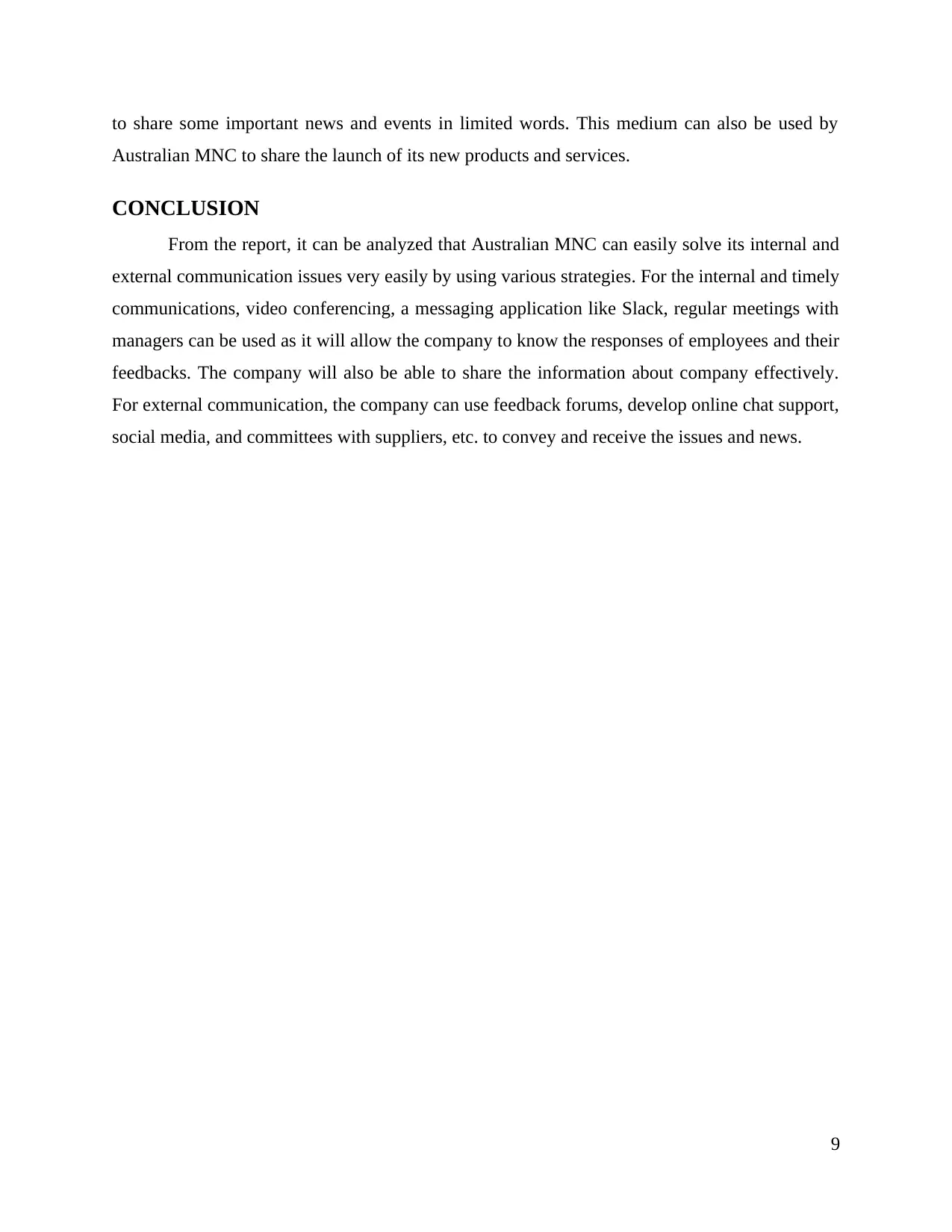
to share some important news and events in limited words. This medium can also be used by
Australian MNC to share the launch of its new products and services.
CONCLUSION
From the report, it can be analyzed that Australian MNC can easily solve its internal and
external communication issues very easily by using various strategies. For the internal and timely
communications, video conferencing, a messaging application like Slack, regular meetings with
managers can be used as it will allow the company to know the responses of employees and their
feedbacks. The company will also be able to share the information about company effectively.
For external communication, the company can use feedback forums, develop online chat support,
social media, and committees with suppliers, etc. to convey and receive the issues and news.
9
Australian MNC to share the launch of its new products and services.
CONCLUSION
From the report, it can be analyzed that Australian MNC can easily solve its internal and
external communication issues very easily by using various strategies. For the internal and timely
communications, video conferencing, a messaging application like Slack, regular meetings with
managers can be used as it will allow the company to know the responses of employees and their
feedbacks. The company will also be able to share the information about company effectively.
For external communication, the company can use feedback forums, develop online chat support,
social media, and committees with suppliers, etc. to convey and receive the issues and news.
9
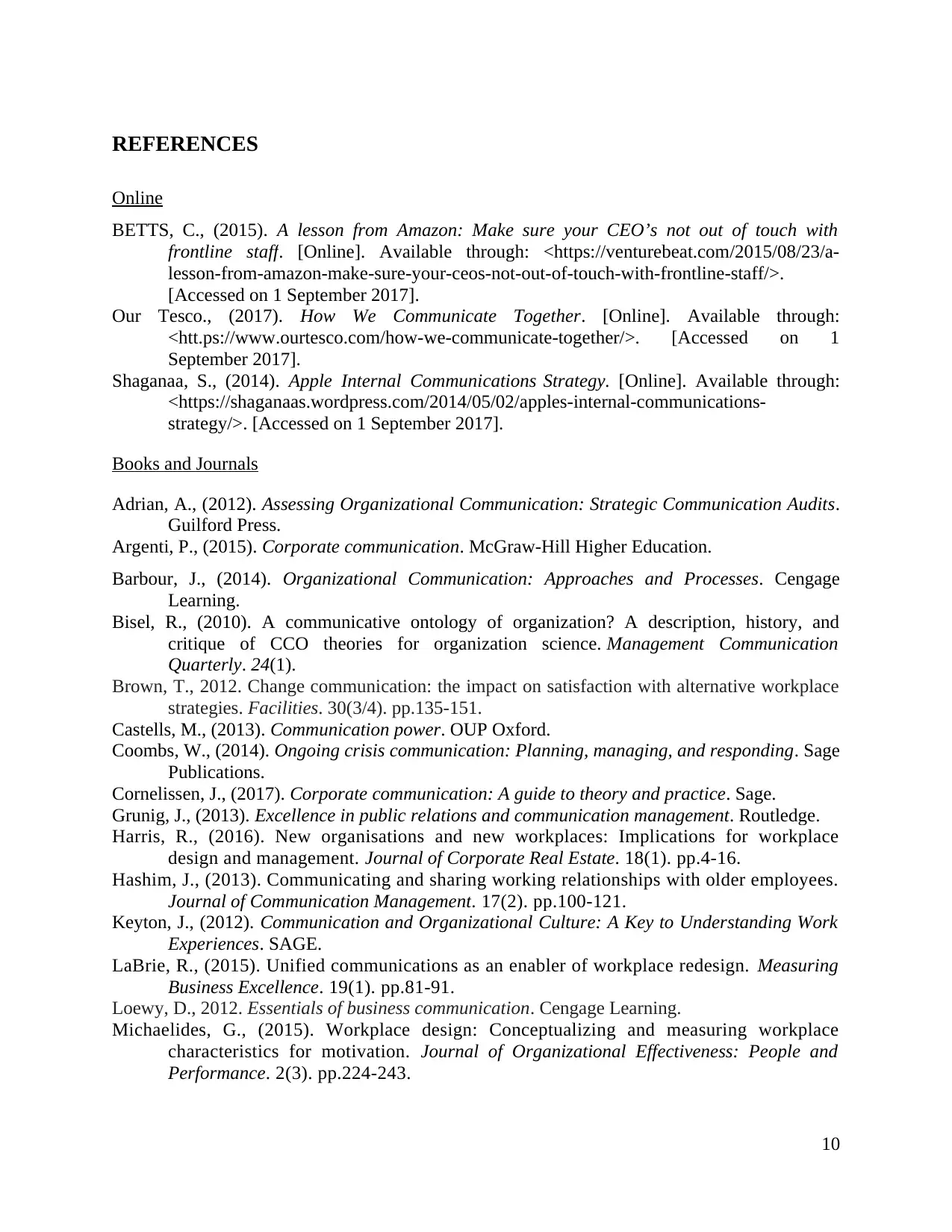
REFERENCES
Online
BETTS, C., (2015). A lesson from Amazon: Make sure your CEO’s not out of touch with
frontline staff. [Online]. Available through: <https://venturebeat.com/2015/08/23/a-
lesson-from-amazon-make-sure-your-ceos-not-out-of-touch-with-frontline-staff/>.
[Accessed on 1 September 2017].
Our Tesco., (2017). How We Communicate Together. [Online]. Available through:
<htt.ps://www.ourtesco.com/how-we-communicate-together/>. [Accessed on 1
September 2017].
Shaganaa, S., (2014). Apple Internal Communications Strategy. [Online]. Available through:
<https://shaganaas.wordpress.com/2014/05/02/apples-internal-communications-
strategy/>. [Accessed on 1 September 2017].
Books and Journals
Adrian, A., (2012). Assessing Organizational Communication: Strategic Communication Audits.
Guilford Press.
Argenti, P., (2015). Corporate communication. McGraw-Hill Higher Education.
Barbour, J., (2014). Organizational Communication: Approaches and Processes. Cengage
Learning.
Bisel, R., (2010). A communicative ontology of organization? A description, history, and
critique of CCO theories for organization science. Management Communication
Quarterly. 24(1).
Brown, T., 2012. Change communication: the impact on satisfaction with alternative workplace
strategies. Facilities. 30(3/4). pp.135-151.
Castells, M., (2013). Communication power. OUP Oxford.
Coombs, W., (2014). Ongoing crisis communication: Planning, managing, and responding. Sage
Publications.
Cornelissen, J., (2017). Corporate communication: A guide to theory and practice. Sage.
Grunig, J., (2013). Excellence in public relations and communication management. Routledge.
Harris, R., (2016). New organisations and new workplaces: Implications for workplace
design and management. Journal of Corporate Real Estate. 18(1). pp.4-16.
Hashim, J., (2013). Communicating and sharing working relationships with older employees.
Journal of Communication Management. 17(2). pp.100-121.
Keyton, J., (2012). Communication and Organizational Culture: A Key to Understanding Work
Experiences. SAGE.
LaBrie, R., (2015). Unified communications as an enabler of workplace redesign. Measuring
Business Excellence. 19(1). pp.81-91.
Loewy, D., 2012. Essentials of business communication. Cengage Learning.
Michaelides, G., (2015). Workplace design: Conceptualizing and measuring workplace
characteristics for motivation. Journal of Organizational Effectiveness: People and
Performance. 2(3). pp.224-243.
10
Online
BETTS, C., (2015). A lesson from Amazon: Make sure your CEO’s not out of touch with
frontline staff. [Online]. Available through: <https://venturebeat.com/2015/08/23/a-
lesson-from-amazon-make-sure-your-ceos-not-out-of-touch-with-frontline-staff/>.
[Accessed on 1 September 2017].
Our Tesco., (2017). How We Communicate Together. [Online]. Available through:
<htt.ps://www.ourtesco.com/how-we-communicate-together/>. [Accessed on 1
September 2017].
Shaganaa, S., (2014). Apple Internal Communications Strategy. [Online]. Available through:
<https://shaganaas.wordpress.com/2014/05/02/apples-internal-communications-
strategy/>. [Accessed on 1 September 2017].
Books and Journals
Adrian, A., (2012). Assessing Organizational Communication: Strategic Communication Audits.
Guilford Press.
Argenti, P., (2015). Corporate communication. McGraw-Hill Higher Education.
Barbour, J., (2014). Organizational Communication: Approaches and Processes. Cengage
Learning.
Bisel, R., (2010). A communicative ontology of organization? A description, history, and
critique of CCO theories for organization science. Management Communication
Quarterly. 24(1).
Brown, T., 2012. Change communication: the impact on satisfaction with alternative workplace
strategies. Facilities. 30(3/4). pp.135-151.
Castells, M., (2013). Communication power. OUP Oxford.
Coombs, W., (2014). Ongoing crisis communication: Planning, managing, and responding. Sage
Publications.
Cornelissen, J., (2017). Corporate communication: A guide to theory and practice. Sage.
Grunig, J., (2013). Excellence in public relations and communication management. Routledge.
Harris, R., (2016). New organisations and new workplaces: Implications for workplace
design and management. Journal of Corporate Real Estate. 18(1). pp.4-16.
Hashim, J., (2013). Communicating and sharing working relationships with older employees.
Journal of Communication Management. 17(2). pp.100-121.
Keyton, J., (2012). Communication and Organizational Culture: A Key to Understanding Work
Experiences. SAGE.
LaBrie, R., (2015). Unified communications as an enabler of workplace redesign. Measuring
Business Excellence. 19(1). pp.81-91.
Loewy, D., 2012. Essentials of business communication. Cengage Learning.
Michaelides, G., (2015). Workplace design: Conceptualizing and measuring workplace
characteristics for motivation. Journal of Organizational Effectiveness: People and
Performance. 2(3). pp.224-243.
10
Secure Best Marks with AI Grader
Need help grading? Try our AI Grader for instant feedback on your assignments.
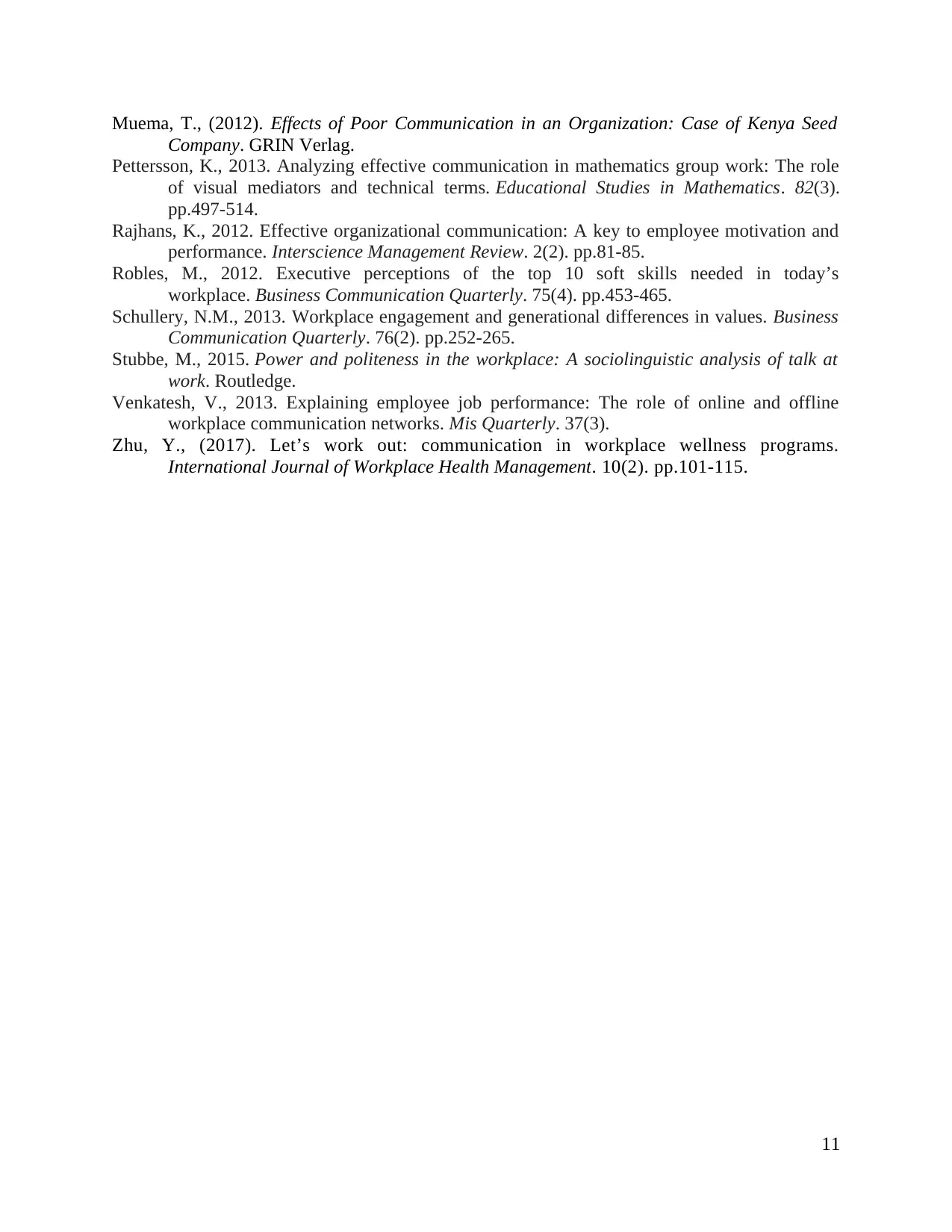
Muema, T., (2012). Effects of Poor Communication in an Organization: Case of Kenya Seed
Company. GRIN Verlag.
Pettersson, K., 2013. Analyzing effective communication in mathematics group work: The role
of visual mediators and technical terms. Educational Studies in Mathematics. 82(3).
pp.497-514.
Rajhans, K., 2012. Effective organizational communication: A key to employee motivation and
performance. Interscience Management Review. 2(2). pp.81-85.
Robles, M., 2012. Executive perceptions of the top 10 soft skills needed in today’s
workplace. Business Communication Quarterly. 75(4). pp.453-465.
Schullery, N.M., 2013. Workplace engagement and generational differences in values. Business
Communication Quarterly. 76(2). pp.252-265.
Stubbe, M., 2015. Power and politeness in the workplace: A sociolinguistic analysis of talk at
work. Routledge.
Venkatesh, V., 2013. Explaining employee job performance: The role of online and offline
workplace communication networks. Mis Quarterly. 37(3).
Zhu, Y., (2017). Let’s work out: communication in workplace wellness programs.
International Journal of Workplace Health Management. 10(2). pp.101-115.
11
Company. GRIN Verlag.
Pettersson, K., 2013. Analyzing effective communication in mathematics group work: The role
of visual mediators and technical terms. Educational Studies in Mathematics. 82(3).
pp.497-514.
Rajhans, K., 2012. Effective organizational communication: A key to employee motivation and
performance. Interscience Management Review. 2(2). pp.81-85.
Robles, M., 2012. Executive perceptions of the top 10 soft skills needed in today’s
workplace. Business Communication Quarterly. 75(4). pp.453-465.
Schullery, N.M., 2013. Workplace engagement and generational differences in values. Business
Communication Quarterly. 76(2). pp.252-265.
Stubbe, M., 2015. Power and politeness in the workplace: A sociolinguistic analysis of talk at
work. Routledge.
Venkatesh, V., 2013. Explaining employee job performance: The role of online and offline
workplace communication networks. Mis Quarterly. 37(3).
Zhu, Y., (2017). Let’s work out: communication in workplace wellness programs.
International Journal of Workplace Health Management. 10(2). pp.101-115.
11
1 out of 11
Related Documents
Your All-in-One AI-Powered Toolkit for Academic Success.
+13062052269
info@desklib.com
Available 24*7 on WhatsApp / Email
![[object Object]](/_next/static/media/star-bottom.7253800d.svg)
Unlock your academic potential
© 2024 | Zucol Services PVT LTD | All rights reserved.





